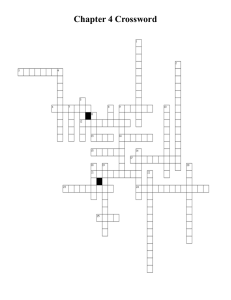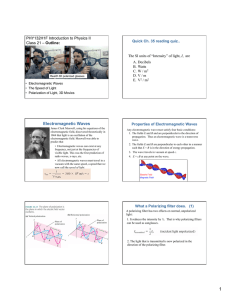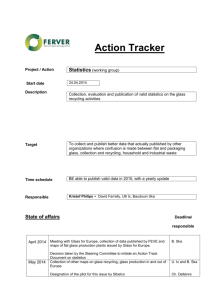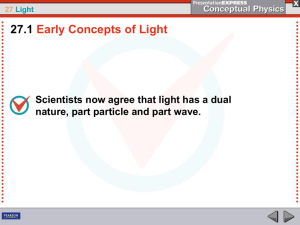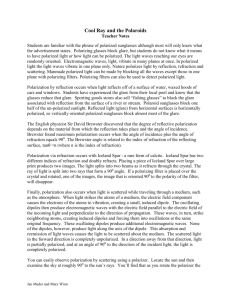Physics@OLY Light Review Sheet Name P ____ 4/11/13 Concept
advertisement
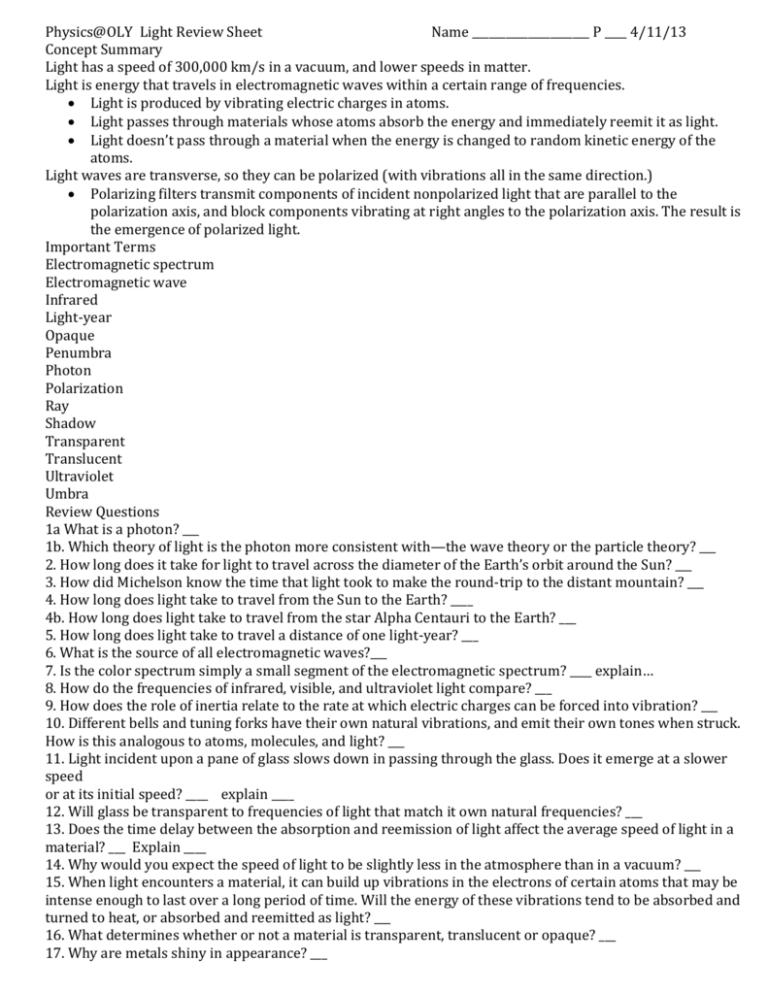
Physics@OLY Light Review Sheet Name _____________________ P ____ 4/11/13 Concept Summary Light has a speed of 300,000 km/s in a vacuum, and lower speeds in matter. Light is energy that travels in electromagnetic waves within a certain range of frequencies. Light is produced by vibrating electric charges in atoms. Light passes through materials whose atoms absorb the energy and immediately reemit it as light. Light doesn’t pass through a material when the energy is changed to random kinetic energy of the atoms. Light waves are transverse, so they can be polarized (with vibrations all in the same direction.) Polarizing filters transmit components of incident nonpolarized light that are parallel to the polarization axis, and block components vibrating at right angles to the polarization axis. The result is the emergence of polarized light. Important Terms Electromagnetic spectrum Electromagnetic wave Infrared Light-year Opaque Penumbra Photon Polarization Ray Shadow Transparent Translucent Ultraviolet Umbra Review Questions 1a What is a photon? ___ 1b. Which theory of light is the photon more consistent with—the wave theory or the particle theory? ___ 2. How long does it take for light to travel across the diameter of the Earth’s orbit around the Sun? ___ 3. How did Michelson know the time that light took to make the round-trip to the distant mountain? ___ 4. How long does light take to travel from the Sun to the Earth? ____ 4b. How long does light take to travel from the star Alpha Centauri to the Earth? ___ 5. How long does light take to travel a distance of one light-year? ___ 6. What is the source of all electromagnetic waves?___ 7. Is the color spectrum simply a small segment of the electromagnetic spectrum? ____ explain… 8. How do the frequencies of infrared, visible, and ultraviolet light compare? ___ 9. How does the role of inertia relate to the rate at which electric charges can be forced into vibration? ___ 10. Different bells and tuning forks have their own natural vibrations, and emit their own tones when struck. How is this analogous to atoms, molecules, and light? ___ 11. Light incident upon a pane of glass slows down in passing through the glass. Does it emerge at a slower speed or at its initial speed? ____ explain ____ 12. Will glass be transparent to frequencies of light that match it own natural frequencies? ___ 13. Does the time delay between the absorption and reemission of light affect the average speed of light in a material? ___ Explain ____ 14. Why would you expect the speed of light to be slightly less in the atmosphere than in a vacuum? ___ 15. When light encounters a material, it can build up vibrations in the electrons of certain atoms that may be intense enough to last over a long period of time. Will the energy of these vibrations tend to be absorbed and turned to heat, or absorbed and reemitted as light? ___ 16. What determines whether or not a material is transparent, translucent or opaque? ___ 17. Why are metals shiny in appearance? ___ 18. Distinguish between an umbra and a penumbra. ___ 19. Distinguish between a solar eclipse and a lunar eclipse. ___ 19b. Which type of eclipse is dangerous to your eyes if viewed directly? ___ 20. What is the difference between light that is polarized and light that is not? ___ 21. Why is light from a common lamp or from a candle flame nonpolarized? ___ 22. In what direction is the polarization of the glare that reflects from a horizontal surface? ___ 23. How do polarizing filters allow each eye to see separate images in the projection of three dimensional slides or movies? ___ Think and Explain 1. What evidence can you cite to support the idea that light can travel through a vacuum? ___ 2. If the octagonal mirror in the Michelson apparatus were spun at twice the speed that produced light in the eyepiece, would light still be seen? ___ 2b. At 2.1 times the speed? ___ 3. If the mirror in Michelson’s apparatus had 6 sides instead of light, would it have had to spin faster or more slowly to measure the speed of light? ___ 4. You can get a sunburn on a sunny day and on an overcast day. But you cannot get a sunburn if you are behind glass. Explain ___ 5. If you fire a bullet through a tree, it will slow down in the tree and emerge at less than its initial speed. But when light shines on a pane of glass, even though it slows down inside, its speed upon emerging is the same as its initial speed. Explain. ___ 6. Short wavelengths of visible light interact more frequently with atoms in glass than do longer wavelengths. Which do you suppose takes longer to get through glass—red light or blue light? ______ 7. Suppose that sunlight is incident upon both a pair of reading glasses and a pair of sunglasses. Which pair would you expect to be warmer, and why? ___ 8. Why does a high-flying plane cast little or no shadow on the ground, while a low –flying airplane casts a sharp shadow? ___ 9. An ideal polarizing filter transmits 50% of the incident nonpolarized light. Why is this so? ___ 10. What % of light would be transmitted by 2 ideal polarizing filters, on atop the other, with their axes aligned? ___ 10b. With their axes crossed at right angles? ___ Be sure to have completed CD 27-1 about this unit. I will also post a power point show on light for you on our assignment page with 10 practice questions at the end.
